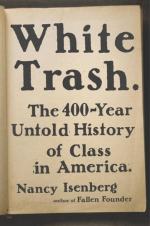|
This section contains 1,324 words (approx. 4 pages at 400 words per page) |

|
The Relationship Between Land and Labor
Isenberg goes to exhaustive lengths to concretely show the intricate relationship between land and labor. Relying heavily on the writings and teachings of the Founding Fathers, she paints a picture of class in which one’s social status directly relied on his ability to make his land profitable. Isenberg uses Jefferson’s model of the virtuous cultivator to further this argument. Cultivators were those who reaped not only produce from the soil, but also planted strong communal and family ties. Success for the American breed meant quelling idleness without giving the poor too much liberty.
Benjamin Franklin as well boasted of a society in which individuals were rewarded for their hard work with an elevated class status. He believed letting settlers expand throughout the continent would naturally create a content middle class of subsistence farmers. Isenberg uses his ideas to highlight the popular...
|
This section contains 1,324 words (approx. 4 pages at 400 words per page) |

|




